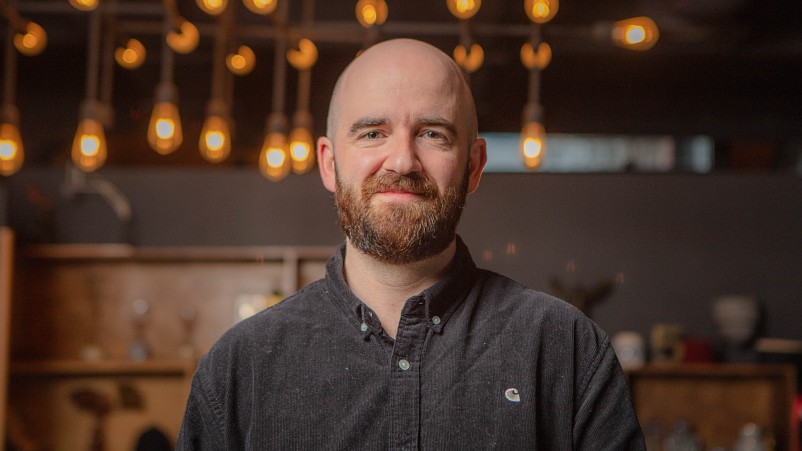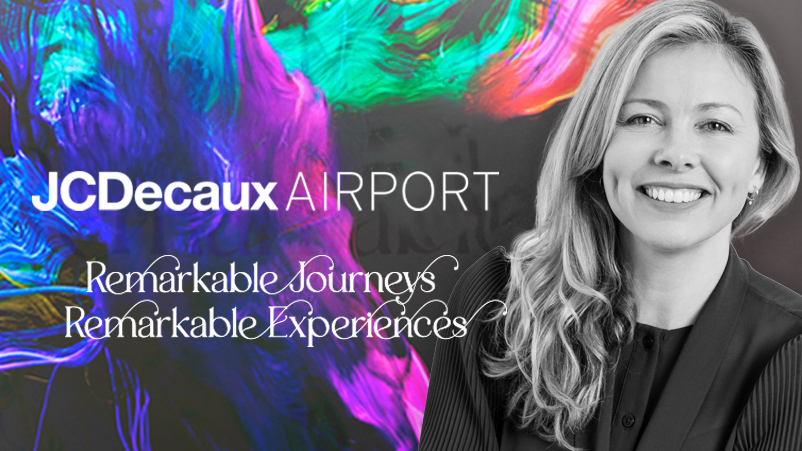‘15 versions of creative for multiple platforms is not marketing… it's just operations’: How Salesforce APAC CMO Leandro Perez’s 100-plus team is applying AI

Media machine: Salesforce APAC CMO Leandro Perez on set in San Francisco with CFO Amy Weaver - the tech giant is creating content and custom serving it to audiences across its owned assets based on AI-powered profile matching.
After a wild week at Salesforce’s global jamboree in San Francisco, the tech giant’s full flip to generative AI was relentlessly hammered home. Like most, the heat is on APAC marketing boss Leandro Perez and his 100-plus regional marketing team to walk the talk, applying Salesforce’s new AI-powered capabilities to his own operation. Perez claims it’s working – from freeing up masses of time to iterate social posts on different platforms, to summarising Slack meetings, driving thousands of personalised iterations and interactions on its website, notching up to 80 per cent engagement rates on email campaigns – and potentially turning customer service teams into sales teams - at least partially. But Perez insists all those productivity gains won’t see teams hollowed out. “We never have enough people to do what we need to do anyway, especially if you have big visions from brand to demand.” Creating 15 versions of a social post and scheduling it “isn’t marketing” anyway, he says, “it’s just operations work. So I personally am not getting any pressure to reduce as a team.” Perez says the major B2B firms he’s speaking with all proffer similar lines. If anything, says Perez, generative AI gains mean he can ask for greater resource – because he can prove to leadership that marketing is powering through greater workloads, in turn driving sales growth. And APAC is Salesforce’s fastest growing market globally. Here’s a few insider learnings from a company selling AI to the world. And where B2B marketing is headed next.
What you need to know:
- Salesforce is pushing new generative AI powered tools into its marketing, sales and data cloud products, as well as Slack, MuleSoft and others.
- APAC CMO Leandro Perez and his 100-strong team have been “customer zero” in testing them.
- He says it’s automating jobs that should never have been classified as marketing in the first place – iterating and translating social posts for different markets, optimising and scheduling emails, summarising endless Slack conversations and getting straight to the decision to name a few.
- Which means his team is getting more high value work done.
- Which in turn makes it easier to ask for more resource – not cut jobs.
- He says the CMOs he's speaking with across categories are thinking along the same lines.
- Plus, Perez thinks there’s a big opportunity for AI to help turn customer service into a new sales channel, while pushing boundaries in personalisation.
- But AI doesn’t come without major risks – and he thinks a lot of businesses are still taking them.
- Get the download on what’s coming next via the podcast.
What we're learning is that the service department can become a sales department too if they have more time, and they're not just measured on getting rid of the customer.
Cutting slack
Salesforce has been building AI capability for a decade but this year flipped fully to generative AI. You couldn’t miss that message at Dreamforce.
APAC CMO Leandro Perez has been using Salesforce’s AI-powered tools, largely housed within EinsteinGPT, for the last six months. Like all marketers, he’s under pressure to drive growth amid ever expanding to-do lists and targets.
He’s running a marketing team of circa 100 and claims APAC is Salesforce’s fastest growing region globally. Perez thinks properly harnessing AI-powered tools can keep it that way – and maybe justify hiring more marketers rather than ushering sweeping job cuts in the name of efficiency. Either way, Salesforce’s marketing team has been “customer zero” for the tools it is now bringing to market.
Perez, who studied computer science prior to becoming a marketer, firmly believes AI-driven automation will free-up both the process-driven and the creative-minded marketers within his team – and he’s already seeing the evidence.
Firstly, he’s no longer spending so much time wading through Slack conversations.
“We’re all big Slack users. My team like all marketers have to keep across so much information. Now we have a generator summaries channel.” That’s handy, says Perez, because teams and leaders can get the top line, and to the decision, without having to plough through reams of conversation.
“It’s a big win for us … there are a lot of productivity gains for the individual, which are not directly [linked to] outbound marketing, but help my team move faster.”
Cutting crap
In terms of outbound marketing, Perez’s team is using the AI tools to iterate social posts, “to have ten variations – make it a little less formal for Australia and a little more formal for Singapore,” for example.
That versioning/iteration can be applied more broadly across creative and content assets: “There’s a lot of capability coming out in Marketing Cloud that we have been using to generate large variations for our campaigns.”
The AI tools have also improved email marketing, “where it can predict the best send time optimisation,” per Perez. “If you're sending a million emails, it's going to work out the best time to send that email based on historical trends. And it does that for you – so that takes something [manual] away from a typical marketer.”
Plus, he says the Einstein tools are helping make executive events that much more relevant to Salesforce’s target customers – and quicker to organise.
“All our sales calls with reps are recorded – and that is all captured in Salesforce. So when my team is planning an executive event, we actually have access to all that information in a summarised form. So if we are inviting a financial services customer, we know what's been the conversation there. So my team can very quickly know the right kind of subject matter expert or a thought leader to bring in.”
Cutting noise
More broadly, Perez said Salesforce is doubling down on personalisation via its website, with “thousands” of different learning “trails” being served to logged-in users based on their industry, the products they use – and potentially the products they should be using next and learning about, priming that sales funnel.
“So on the homepage, there are four or five personalisable blocks. But within the learning [aspect], we have thousands of modules. So the combinations are pretty endless,” says Perez. “That part of the website is down to you, so it is one-to-one marketing.”
Is all that personalisation and relevance actually moving the needle for Salesforce? Because while channels such as email are a marketing workhorse, open rates can be pretty anaemic.
“Absolutely,” says Perez, though qualifies that the level of personalisation depends on the use case. But he suggests relevance will always pay off – and says Salesforce is seeing massive open rates as a result.
“We know when a customer is using more than 90 per cent of their licenses for a product like Marketing Cloud or Sales Cloud. But there is a self-service capability, so if they want to increase their licences – they can. We know that when we send them that email, because it's to the person that controls the Salesforce [licences and access] it's very relevant, because if they don't take an action, they may reach a capacity issue. Or it may be the opposite, that they're under-utilised, so they can give more people access to Salesforce. So it's very relevant to them – and we are seeing 80 per cent-plus engagement on an email like that,” says Perez.
Not all of its use cases are as relevant or as high yielding, he admits. “But I'm pushing the team to go more towards that. Because it’s less noise, more interesting. It helps the customer and helps us at the same time.”
Not cutting jobs…
While the world is grappling with the impact of AI on jobs, Perez suggests his team is safe, despite the list of AI-driven efficiency gains. He thinks AI could actually help justify more hires – and claims his conversations with other CMOs suggest few are preparing major headcount reductions.
“We never have enough people to do what we need to do anyway – especially if you have big visions from brand to demand. So there's no shortage of work. Over the years we [marketers] have given ourselves more tasks. When social media came out, you might have done one post. Now there are multiple platforms, you need to post the same thing multiple times to make sure people see it. So that became 'busy work',” says Perez.
“But creating 15 versions and reposting across other platforms, and then ensuring they get scheduled is not marketing. It's just operations work … Having AI augment and be the co-pilot for the human, and create multiple versions so that [humans] can then do the creative work on the next version is where we get [back] productivity again,” he adds.
“We’re a growing company, we want to tackle more challenges and we need creative people to do that. So for me, [generative AI] is about taking away some of the work that truly was never marketing and unlocking that creativity.”
Perez admits he’s not presiding over a department of “Van Goghs sitting there thinking about the next piece of art” in terms of creativity. But he says both the creative and the process aspects of marketing will gain from better use of AI and automation.
“It’s as simple as someone can spend more time on the copy for a headline on the website … Someone else might be [able to spend more time figuring out a] better way to deliver that video experience for an event,” says Perez.
“There is still process involved in making that happen, you still need to deal potentially with an internal team or an agency, and there's processes that don't go away.
“But when that starts to get into production – let's translate that into multiple languages, or let's work out how we would scale that across the website with variations to test the copy – that's gone away.”
…generating jobs
Perez says the efficiencies Salesforce’s marketing team is starting to bank mean he’s having “less conversations” with sales counterparts about what marketing has not been able to deliver. Which means it's “an easier conversation with leadership” when it comes to asking for more resource.
“[I can show them] I'm actually getting through more and it's working, it's delivering for the company. So now it's can I have more [to keep driving growth] versus just saying can I have more because I can't do it.”
While across the piste, cost control is king, he thinks the same applies across all verticals: AI used properly can generate and fund more jobs.
“Generally the customers I talk to, I'm not hearing them say ‘I'm looking to halve my customer service team’. If anything, it's about how can I get them to do more valuable work?” says Perez.
He thinks AI can bring service and sales closer together – with airlines a prime candidate.
“What we're learning is that the service department can become a sales department too if they have more time, and they're not just measured on getting rid of the customer,” says Perez.
“Historically, if you call an airline, it’s like how quickly can they get you off [the phone]. Whereas if they know me, they know I travel a lot: Today I'm here in San Francisco, next week, I'm going to be in Singapore. If they told me that there's a better flight and maybe I want to stay at this hotel versus that hotel, because there's an upgrade and maybe WiFi and do I want to buy it now? I'd be like, sure. That sounds great. As opposed to when I call up they're just trying to get rid of me. So that's happening a lot – and it's not just the high end brands, because everyone wants to differentiate on customer experience.”
You are training someone else’s language learning model ... and that's a risk which by the way is still happening [for] most people out there.
Risks ahead
But there are risks for businesses embedding and harnessing generative AI – and not just the risk of hallucinations, or lies, as Salesforce boss Marc Benioff puts it.
“You are training someone else’s language learning model,” says Perez. Salesforce very early issued a diktat that no customer data was to be put into prompts, he says. “That's something we we're very proactive with. So that's a risk, which by the way is still happening [for] most people out there.”
“Everything that we use is based on our language models, you can use external [data], but it never leaves your instance.”
Plus, claims Perez, that means fewer ‘lies’. “You don't have as many hallucinations because it is grounded with the information you provide it.”
But even though Salesforce’s marketing team is tasked with both trialling and selling its new AI-powered tools, Perez says he’s still treading “with caution, ensuring we don’t go and do things we’re not comfortable with”.
Get the full download. Listen to the podcast here.


